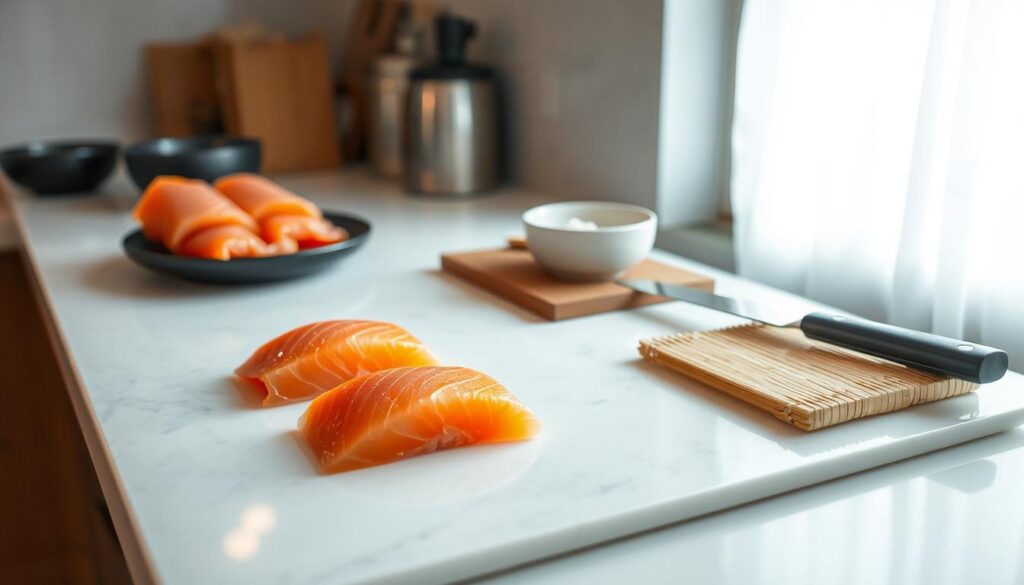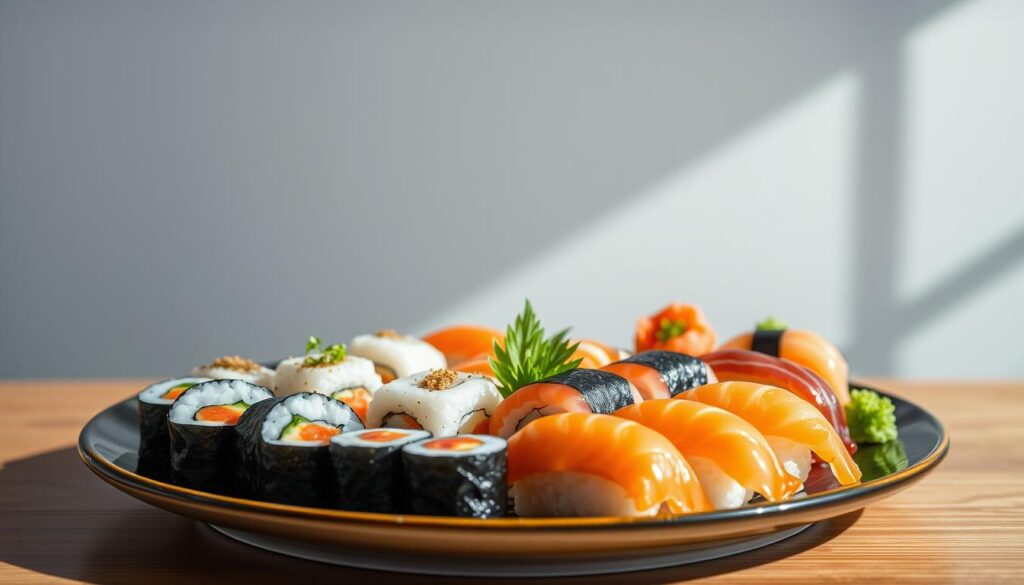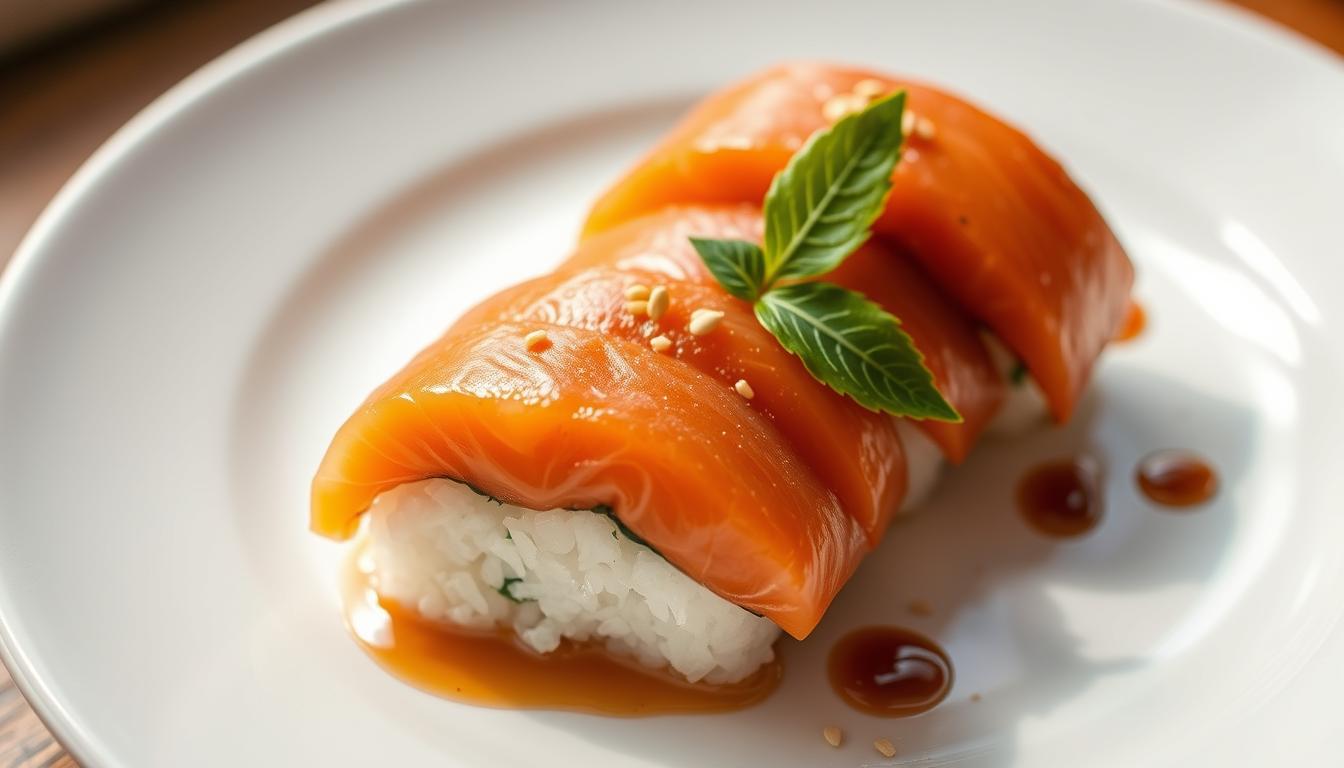Sake Nigiri Guide: Origins, Ingredients & Preparation
The first time I tasted fresh sake nigiri, it was magical. A delicate slice of salmon on perfectly seasoned rice took me to Tokyo’s streets. It’s more than food—it’s a journey through Japanese tradition.
Sake nigiri sushi is a treasure of Japanese culture. It started in 1824 on the Sumida River. Now, it’s loved by food lovers everywhere.
Start your sake sushi adventure here. It’s a journey of flavors, techniques, and tradition. It will change how you see this Japanese delicacy.
Table of Contents
Understanding Traditional Japanese Nigiri Sushi
Explore the world of traditional nigiri sushi, a true art form at the heart of Japanese cuisine. It’s more than just food; it’s a cultural treasure loved by many.
In Tokyo’s mid-19th century, nigiri sushi was born. Street vendors served fresh fish on seasoned rice, making a tasty, portable meal. This quickly became a key part of Japanese street food.
Evolution of Nigiri in Japanese Cuisine
Nigiri sushi’s journey shows Japan’s culinary creativity. It started as street food and evolved into a fine dining experience:
- 1830s: Initial street vendor preparations
- 1880s: Standardization of hand-pressed techniques
- 1900s: Introduction in formal dining settings
- Modern era: Global culinary recognition
Cultural Significance and Dining Etiquette
In Japan, nigiri is a revered art form. Chefs spend years perfecting the balance of rice, fish, and presentation. This is what makes authentic Japanese nigiri special.
Regional Variations Across Japan
Japan’s regions offer unique nigiri styles, using local ingredients and traditions. Hokkaido’s cold-water fish and Kyushu’s tropical seafood add their own flavors to this dish.
Learning about traditional nigiri sushi’s cultural background and preparation techniques enriches your appreciation for it.
The Art of Sake Nigiri: From Ocean to Plate
Making the best sake nigiri is a journey from the ocean to your plate. It starts with choosing the right raw salmon sushi. This requires knowing a lot about fish quality, how to handle it, and how to prepare it.
Salmon for nigiri is special. Chefs pick the best cuts for several reasons:
- Fat content and marbling
- Texture and firmness
- Freshness and origin
- Sustainable fishing practices
Professional sushi chefs know how important handling is. They follow strict rules to keep the fish’s flavor and texture perfect. Proper storage, immediate chilling, and precise cutting techniques are key to making great sake nigiri.
The way salmon is caught matters a lot. It affects how much and how good the nigiri is. Choosing sustainable fishing helps the ocean and supports local fishing communities.
| Salmon Quality Factors | Impact on Nigiri |
|---|---|
| Fat Content | Determines richness and flavor |
| Freshness | Ensures safety and optimal taste |
| Cutting Technique | Influences texture and presentation |
Enjoying sake nigiri is a special experience. It’s a mix of skill, knowledge, and respect for the ingredients. From picking the salmon to the final slice, every step is important for a great sushi experience.
Essential Ingredients for Perfect Sake Nigiri
Making perfect sushi restaurant sake nigiri needs precision, passion, and the right ingredients. Your journey starts with knowing the key parts that make simple ingredients into a great meal.
The base of amazing japanese rice with salmon is top-quality ingredients. Each part is vital for a memorable bite that takes you to Japan’s heart.
Selecting Premium Salmon
Choosing the right salmon is key for great nigiri. Look for these important traits:
- Bright, vibrant color with a rich, deep pink or orange hue
- Firm, glossy texture without any discoloration
- Fresh, clean ocean scent
- Sashimi-grade quality from trusted seafood suppliers
Sushi Rice Preparation Techniques
Sushi rice needs careful attention. Chefs spend years mastering it, knowing rice is nigiri’s soul. Short-grain Japanese rice needs exact cooking and seasoning for the right balance.
- Rinse rice well to remove excess starch
- Cook using traditional methods or modern rice cookers
- Season with rice vinegar, sugar, and salt
- Cool rice to room temperature while keeping it moist
Supporting Ingredients and Garnishes
Boost your sake nigiri with chosen accompaniments that improve flavor and look:
- Fresh wasabi root for real heat
- High-quality soy sauce
- Pickled ginger for palate cleansing
- Delicate sesame seeds or microgreens
Step-by-Step Sake Nigiri Preparation
Making delicious sake nigiri sushi at home needs focus and practice. This guide will show you how to make authentic salmon nigiri, just like a pro.

- Sushi-grade salmon
- Perfectly cooked sushi rice
- Fresh wasabi paste
- Sharp kitchen knife
- Clean cutting board
The art of making sake nigiri involves key techniques. First, prepare your sushi rice with vinegar. Make sure it’s warm and sticky.
- Slice salmon into thin, uniform pieces
- Shape small rice mounds with wet hands
- Apply a small wasabi dot to the rice
- Gently place salmon slice on top
- Press lightly to create perfect shape
Getting good at sake nigiri takes time. Don’t worry if it’s not perfect at first. With practice, you’ll get the hang of it.
| Technique | Key Considerations |
|---|---|
| Rice Preparation | Use short-grain rice, rinse thoroughly, cook with precise water ratio |
| Salmon Slicing | Use extremely sharp knife, slice against grain, maintain uniform thickness |
| Shaping Nigiri | Keep hands slightly wet, gentle pressure, maintain loose but connected texture |
Remember, temperature is key for great sake nigiri. Serve it right away for the best flavor and texture.
Mastering Knife Skills for Salmon Slicing
Making great fresh sake sushi needs precision and the right tools. To become a home sushi master, start by learning how important knife skills are for salmon sashimi on rice.
Professional sushi chefs see knife mastery as an art. It turns raw ingredients into amazing dishes. The right knife can take your sushi from amateur to restaurant-quality.
Traditional Japanese Knife Types
Japanese knives are made for specific tasks. For salmon, you’ll need two main types:
- Yanagiba: A long, single-beveled knife great for slicing raw fish
- Deba: A heavy knife perfect for cutting down whole fish
Proper Cutting Techniques
To slice salmon for fresh sake sushi, use the right technique. Hold the knife at a 15-degree angle and move it in smooth, one-way strokes. Each slice should be about 1/4 inch thick for a beautiful presentation on your salmon sashimi on rice.
Maintaining Blade Sharpness
Sharp knives are key for clean cuts. Get a quality whetstone and learn to sharpen it. Keeping your knife sharp prevents crushing fish fibers and gives you clean, professional slices every time.
Nutritional Benefits and Health Considerations
Raw salmon sushi is more than a tasty treat. It’s packed with nutrients that boost your health. Salmon is known for its great nutritional value, making it a top pick for those who care about their health.
The nutritional perks of sake nigiri are quite impressive. Let’s look at what a 100g serving brings:
| Nutrient | Amount |
|---|---|
| Calories | 145 |
| Protein | 12g |
| Carbohydrates | 18g |
| Fat | 3.5g |
| Omega-3 Fatty Acids | 1.2g |
Raw salmon sushi has many health benefits:
- Heart Health: Omega-3 fatty acids lower inflammation
- Protein Source: Helps build and repair muscles
- Brain Function: Nutrients are good for your brain
Even though sake nigiri is nutritious, food safety is key. Raw fish can be risky for some. Pregnant women, young kids, older adults, and those with weak immune systems should talk to doctors before eating raw salmon sushi.
When you enjoy sake nigiri, pick the freshest salmon from trusted places. Good handling and storage are important. They help avoid health risks and keep the nutritional benefits of this Japanese dish.
Pairing Sake Nigiri with Traditional Accompaniments
Enhancing your Japanese nigiri experience is more than just the fish. The right sides can turn your sushi into a feast for your senses.
Wasabi and Soy Sauce Guidelines
Wasabi adds a unique zing to your sushi. Here’s how to enjoy it right:
- Use genuine wasabi sparingly
- Place a small amount directly on the fish
- Dip nigiri lightly in soy sauce
Complementary Beverages
Choosing the right drink can make your sake nigiri even better. Here are some classic choices:
| Beverage | Flavor Profile | Recommendation |
|---|---|---|
| Sake | Smooth, rice-based | Best traditional pairing |
| Green Tea | Subtle, earthy | Cleanses palate |
| White Wine | Crisp, light | Modern alternative |
Seasonal Pairings
Sushi lovers know that seasons matter. Each season brings its own special sides:
- Spring: Light pickled vegetables
- Summer: Chilled miso soup
- Autumn: Grilled mushroom sides
- Winter: Warm sake and hearty garnishes
By focusing on these details, you’ll elevate your sake nigiri into a true Japanese feast.
Quality Assessment and Storage Tips

Enjoying fresh sake sushi means knowing how to check its quality. This is true for both home cooks and fans of sushi restaurant sake nigiri. Start by looking at the fish and rice carefully.
Signs of top-notch sake nigiri include:
- Vibrant, translucent salmon color
- Smooth, glossy fish surface
- Clean, ocean-like aroma without strong fishy smell
- Firm yet tender fish texture
- Perfectly seasoned, slightly sticky rice
Keeping the right temperature is key to sushi quality. Always keep raw fish refrigerated at temperatures below 40°F (4°C). For the best taste and safety, eat your sake nigiri within 24 hours.
At a sushi restaurant, watch how they prepare your meal. The best places will show:
- Transparent fish storage
- Skilled chefs using precise cutting techniques
- Frequent ingredient rotation
- Clean, organized workspace
For home, use airtight containers and keep fish on ice. Eat it fast to keep the flavors of your fresh sake sushi.
Conclusion
Exploring sake nigiri shows us a deep connection to Japanese food culture. It’s not just about making sushi; it’s a tradition passed down through generations. Each piece of salmon is a perfect mix of skill, quality ingredients, and cultural heritage.
Sake nigiri is more than a tasty meal; it’s a sensory journey into Japanese cuisine. Learning about choosing the best salmon, preparing rice, and using traditional knives changes how you see sushi. Whether making it at home or enjoying it at a fancy restaurant, you’ll see the beauty in every piece.
The world of salmon nigiri sushi is always changing, blending old ways with new ideas. With your new knowledge, you can enjoy this dish with a deeper understanding and respect. By knowing its history, ingredients, and how it’s made, you’re part of a global food conversation that honors Japanese culinary art.
As sushi culture grows worldwide, sake nigiri shows the lasting charm of simple, high-quality food made with great skill. Your exploration of this dish opens up new culinary adventures and a deeper appreciation for Japanese food traditions.
FAQ
What is sake nigiri?
Is sake nigiri safe to eat?
How do I know if the salmon is fresh enough for nigiri?
Can I make sake nigiri at home?
What’s the best way to eat sake nigiri?
What nutritional benefits does sake nigiri offer?
What beverages pair well with sake nigiri?
How long can I store salmon for nigiri?
Are there different types of salmon used in nigiri?
What is the difference between sake nigiri and salmon sashimi?
There are no reviews yet. Be the first one to write one.

